Beaked Whale Discoverer Dies
Posted by: Loren Coleman on February 25th, 2007
As important as he became as a scientist, he never stopped being the boy who came home for dinner with a frog in one pocket and a crawfish in the other. His love of all marine life was both infectious and inspiring.Paul G. Haaga Jr, museum board member
recalls John E. Heyning
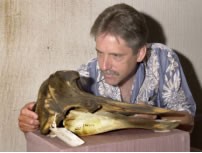
John Heyning, deputy director of the research and collections at the Natural History Museum of Los Angeles County, places one of the specimens used to genetically identify a rare-beaked whale on display.
John E. Heyning, 50, one of the world’s foremost marine biologist, has died. Heyning’s speciality was ziphiids, beaked whales, which make up about a quarter of the whale population, and their evolution. He also showed that the common dolphin, long believed to be one species, was actually two. He was a marine biologist with the Natural History Museum of Los Angeles County and helped build one of the world’s largest collections of marine mammal specimens (over 4000 specimens). He authored monographs and the book Masters of the Ocean Realm: Whales, Dolphins, and Porpoises
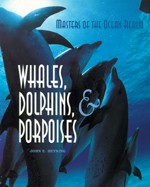
Most new mammal species at the end of the 20th century and beginning of the 21st century have not been discovered on land, but in the oceans and on the nearby shores. Most have been ziphiids. At a 2001 Vancouver conference, as many as twenty-six additional new ziphiid species were documented by molecular analysis. The discoveries being discussed there were so common that year the joke among cryptozoologists was that “you can’t go to the beach in the Western Hemisphere without tripping over a new ziphiid.”

Most of the 83 species of living cetaceans known are based on specimens collected during the 18th and 19th centuries. Of the more recently described new species, most have been beaked whales due to the difficulty in studying these rarely seen deep-water animals. For example, only 3% (1/34) of living oceanic dolphins (Delphinidae) have been described since 1900, whereas 40% (8/20) of beaked whale species have been described in the same timeframe.
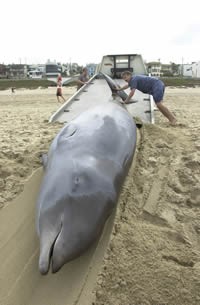
Heyning (above) was one of those leading the way, along with other scientists such as James Mead, Robert L. Pitman, and Merel Dalebout, in documenting and discovering these new ziphiids. Known as the “Whale Man,” Heyning earned the nickname through decades of hauling away stranded whales and other cetaceans from Southern California beaches. Heyning is also credited with discovering some interesting aligned new species, such as the whale lice (below) that live on cetaceans.
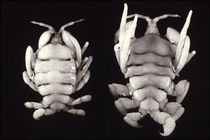
In the mid-1970s, four rare beaked whales washed ashore on the coast near San Diego, California. Then in 2002, the new species Mesoplodon perrini, named after marine mammal systematist and conservationist William F. Perrin, was formally described in the quarterly journal Marine Mammal Science, after a genetic analysis of those specimens. Two of the five specimens used to identify the new species were archived at the Natural History Museum of Los Angeles County, with one (below) on public display.
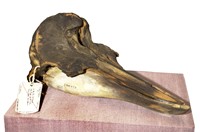
The current finding is remarkable in several ways. This discovery exemplifies how museum specimens collected decades, or even centuries, ago continue to contribute to our current understanding of the natural world. It is also remarkable that the new species washed ashore along the California coast; waters considered relatively well known biologically. The recent recognition of a new whale from these relatively well scrutinized waters highlights how little we know about the biological diversity in the ocean. John Heyning, speaking in 2002, about Mesoplodon perrini.
John E. Heyning, still with passion for animals, died February 17, 2007, at Little Company of Mary Hospital in Torrance, California, after suffering from Lou Gehrig’s disease for more than three years, the museum announced on February 24th.

About Loren Coleman
Loren Coleman is one of the world’s leading cryptozoologists, some say “the” leading living cryptozoologist. Certainly, he is acknowledged as the current living American researcher and writer who has most popularized cryptozoology in the late 20th and early 21st centuries.
Starting his fieldwork and investigations in 1960, after traveling and trekking extensively in pursuit of cryptozoological mysteries, Coleman began writing to share his experiences in 1969. An honorary member of Ivan T. Sanderson’s Society for the Investigation of the Unexplained in the 1970s, Coleman has been bestowed with similar honorary memberships of the North Idaho College Cryptozoology Club in 1983, and in subsequent years, that of the British Columbia Scientific Cryptozoology Club, CryptoSafari International, and other international organizations. He was also a Life Member and Benefactor of the International Society of Cryptozoology (now-defunct).
Loren Coleman’s daily blog, as a member of the Cryptomundo Team, served as an ongoing avenue of communication for the ever-growing body of cryptozoo news from 2005 through 2013. He returned as an infrequent contributor beginning Halloween week of 2015.
Coleman is the founder in 2003, and current director of the International Cryptozoology Museum in Portland, Maine.










This was very sad news to hear of John Heyning’s death. I think there is no doubt that the oceans hold more secrets and are really a vast frontier of possible cryptid habitats. It is not only the sheer size of the ocean, but the difficulty involved in going out to research it, and the relatively lack of knowledge we have of all its ecosystems and biodiversity. The oceans have even brought forth wholly new ecosystems never thought even possible, such as the life around deep sea vents which have given new hope to the thought of life on other worlds and astrobiology in general. I feel there are still many exciting finds to be made in the deep blue sea and people like Mr. Heyning are essential to helping uncover these new discoveries. May he rest in peace.
I’m saddened to hear of John Heyning’s passing. His enthusiasm will live on in those whom he inspired.
Thanks to his work, I need to get a really up to date book on cetaceans. I had no idea so many new beaked whales had been discovered. Rest in Peace Mr. Heyning, and thank you.
Heyning was everything a scientist should be – dedicated, endlessly curious, and open-minded. He will be greatly missed.